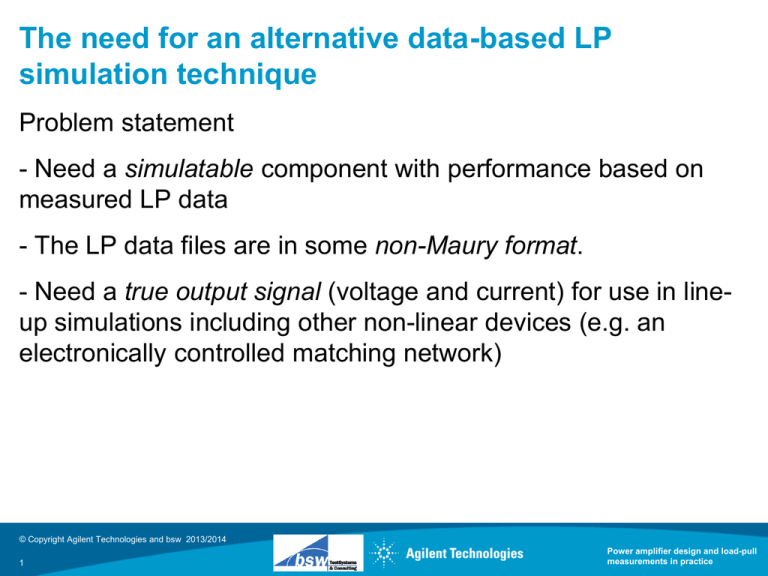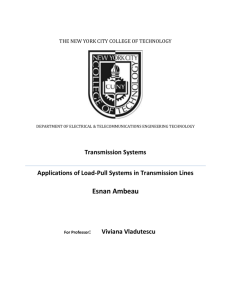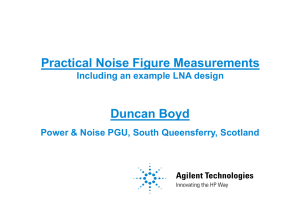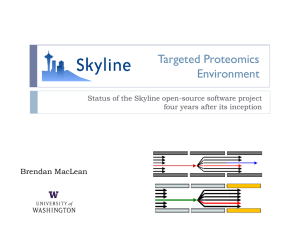Another_load_pull_model
advertisement

The need for an alternative data-based LP simulation technique Problem statement - Need a simulatable component with performance based on measured LP data - The LP data files are in some non-Maury format. - Need a true output signal (voltage and current) for use in lineup simulations including other non-linear devices (e.g. an electronically controlled matching network) © Copyright Agilent Technologies and bsw 2013/2014 1 Power amplifier design and load-pull measurements in practice MGA-31189 Datasheet only provides numbers for P1dB, Gain and OIP3 when terminated with 50 Ohm. Device is characterized at different loads with a custom (non-Maury) LP set-up © Copyright Agilent Technologies and bsw 2013/2014 2 Power amplifier design and load-pull measurements in practice Solution: build our own component based on two special ADS components: FDD and DAC. © Copyright Agilent Technologies and bsw 2013/2014 3 Power amplifier design and load-pull measurements in practice How does it work? The FDD ("Frequency Defined Device") senses the load impedance seen at its output terminal. The power associated with this load impedance is looked-up (using the sensed load values) from the MDIF formatted loadpull data DAC (Data Access Component). The FDD's output voltage is then set to deliver the looked-up power to the load. © Copyright Agilent Technologies and bsw 2013/2014 4 Power amplifier design and load-pull measurements in practice Under the hood Z_sensed V/I © Copyright Agilent Technologies and bsw 2013/2014 5 Power amplifier design and load-pull measurements in practice Under the hood Z_sensed V I © Copyright Agilent Technologies and bsw 2013/2014 6 Power amplifier design and load-pull measurements in practice Under the hood Z_sensed V I © Copyright Agilent Technologies and bsw 2013/2014 7 Power amplifier design and load-pull measurements in practice Under the hood Z_sensed V I © Copyright Agilent Technologies and bsw 2013/2014 8 Power amplifier design and load-pull measurements in practice Requirements for the load-pull data to be usable by this model The load-pull data should be structured as a generic MDIF file. The independent variables in the load-pull data (typically the VSWR and phase of the load) should be monotonic and constant for a range of inner (faster changing) independent variables. (a.k.a. "rectangular" data. i.e., not "scattered" data.) Additional independent variables e.g. Frequency, Temperature, Vbias, Pin, etc. are supported as long as they are monotonic and constant for a range of inner independent variables. © Copyright Agilent Technologies and bsw 2013/2014 10 Power amplifier design and load-pull measurements in practice Generic MDIF format Generic MDIF consists of blocks with formatted data. var1Name, var2Name, VarNName are the independents as well as bVar1Name (the most inner -fastest changing- independent) bVar2Name, bVar3Name are the dependents. © Copyright Agilent Technologies and bsw 2013/2014 11 Power amplifier design and load-pull measurements in practice Section of Generic MDIF file mga31189_LP_data.mdf © Copyright Agilent Technologies and bsw 2013/2014 12 Power amplifier design and load-pull measurements in practice Example mga31189.lpd LP data files that needs reformatting and merging. Join files taken at different frequencies and make Frequency a VAR Not monotonous, needs re-ordering Break into blocks of equal Gamma values and variable Phase © Copyright Agilent Technologies and bsw 2013/2014 13 Power amplifier design and load-pull measurements in practice File reformatted to generic MDIF (use a script or Excel and ascii text editor) © Copyright Agilent Technologies and bsw 2013/2014 14 Power amplifier design and load-pull measurements in practice Use new LP_data_model to create contour plots Load tuner represents (harmonic) impedance on Smith chart. FDD requires HB simulator Sweeps arranged to create VSWR circles with load tuner. © Copyright Agilent Technologies and bsw 2013/2014 15 Power amplifier design and load-pull measurements in practice Pout and OIP3 contours at 1900 MHz Pout optimum is quite different from OIP3 optimum. Discontinuity caused by extrapolation on sparse data around -180 degrees in LP file. © Copyright Agilent Technologies and bsw 2013/2014 16 Power amplifier design and load-pull measurements in practice Long extrapolation required near -180 degrees due to limited number of data points. > > © Copyright Agilent Technologies and bsw 2013/2014 17 Power amplifier design and load-pull measurements in practice Copy data from +180 degrees area to -180 area © Copyright Agilent Technologies and bsw 2013/2014 18 Power amplifier design and load-pull measurements in practice Discontinuity removed by augmenting data in -180 degrees area. © Copyright Agilent Technologies and bsw 2013/2014 19 Power amplifier design and load-pull measurements in practice










